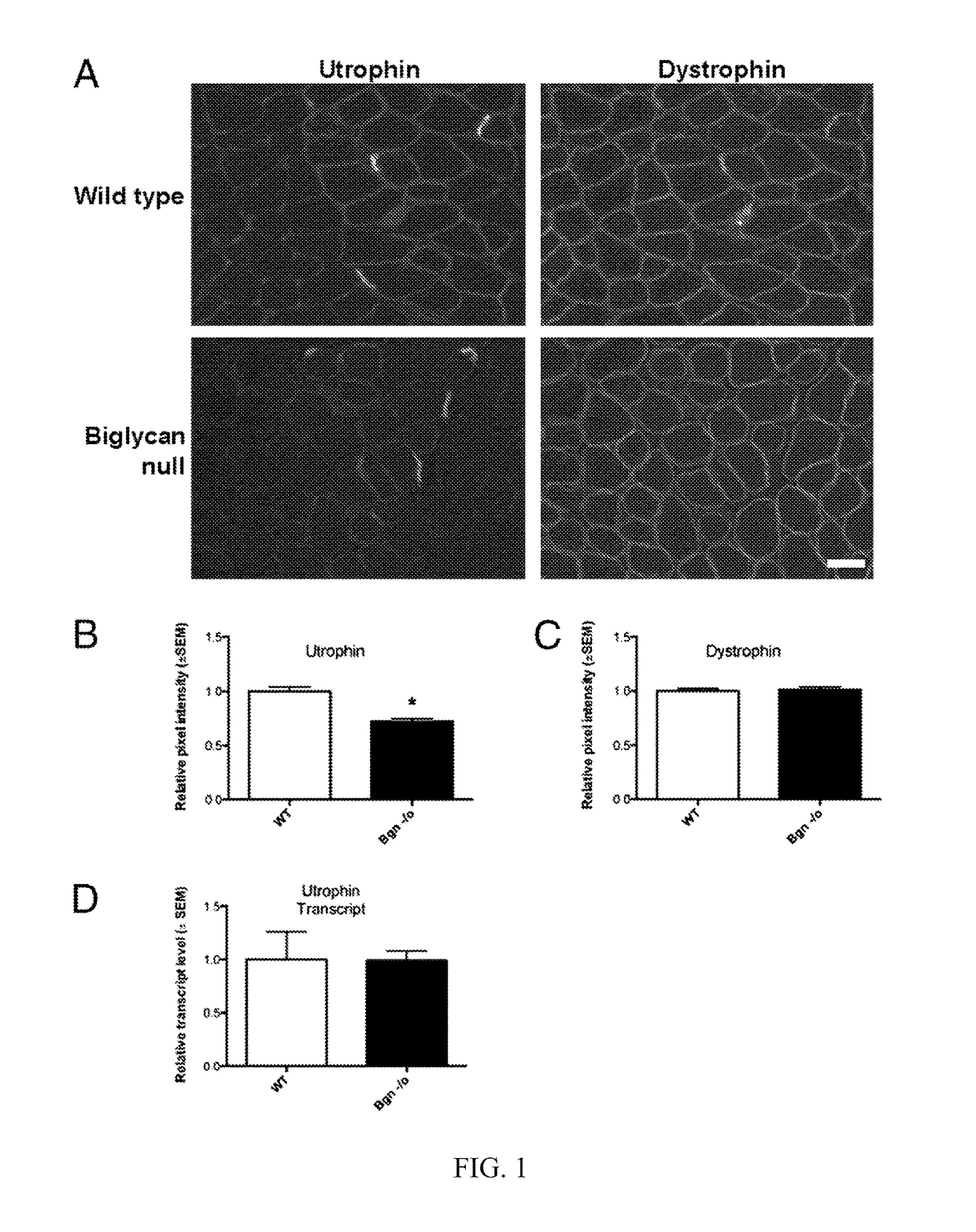Therapeutic and diagnostic methods involving biglycan and utrophin
a diagnostic method and biglycan technology, applied in the field of biglycan and utrophin therapy and diagnostic methods, can solve the problems of debilitating and often fatal clinical outcomes, unclear how agrin stimulates musculature, and insufficient musculoskeletal phosphorylation, so as to improve muscle function and improve muscle function
- Summary
- Abstract
- Description
- Claims
- Application Information
AI Technical Summary
Benefits of technology
Problems solved by technology
Method used
Image
Examples
example 1
s Biglycan Regulates Utrophin Expression in Immature Muscle
[0248]At postnatal day 14 (P14), utrophin is highly expressed in the perisynaptic sarcolemma (FIG. 1A) (9). To compare utrophin expression levels in the presence and absence of biglycan, we immunostained sections of muscle from bgn− / o mice and age-matched congenic controls. In all cases, the mutant and WT sections were mounted on the same slides, stained together and imaged concurrently (Materials and Methods). FIG. 1A shows that utrophin expression is decreased at the perisynaptic sarcolemma in bgn− / o muscle, whereas sarcolemmal dystrophin expression was unchanged. Quantification of 50 sarcolemmal segments from each of three animals from each genotype showed that utrophin levels were reduced by ˜28% (FIG. 1B; Bgn− / o: 0.72±0.03, WT: 1.0±0.04, unpaired Student t test, P<0.0001). In contrast, there was no significant difference in the expression of dystrophin in the sarcolemma (FIG. 1C; Bgn− / o: 1.01±0.03, WT: 1.00±0.03, unpair...
example 2
atment Up-Regulates Membrane-Associated Utrophin in Cultured Muscle Cells
[0249]We next turned to a cell culture system to more precisely delineate the role of biglycan in regulating utrophin association with the sarcolemma. We stimulated bgn− / o myotubes with 1 nM rhBGN and assessed the levels of utrophin and γ-sarcoglycan in membrane fractions by Western blotting. As shown in FIG. 2A, rhBGN treatment up-regulates utrophin and γ-sarcoglycan protein in these membrane fractions. On the other hand, there was a reduction in utrophin transcript levels following rhBGN treatment (untreated: 1±0.10; rhBGN treated: 0.7±0.06; unpaired Student t test, P=0.02; n=6 separate experiments with three replicate flasks in each). Thus, the up-regulation of utrophin protein expression at the membrane is not associated with increases in the level of its transcript.
[0250]The results described above suggest that biglycan could regulate utrophin protein by mechanisms involving elevated translation, increased...
example 3
Delivery of rhBGN
[0251]The role for biglycan in recruiting utrophin to the membrane, taken together with previous results, showing that both endogenous biglycan and intramuscularly delivered rhBGN can regulate DAPC proteins in vivo (15), suggesting that rhBGN could be a therapeutic agent for DMD. This experiment shows that rhBGN can be delivered systemically. A capture ELISA showed that rhBGN was readily detected in the circulation 30 and 60 min after i.p. delivery (FIG. 7A). To detect the recombinant protein in tissue, where endogenous biglycan is expressed (13), we injected animals i.p. with rhBGN conjugated to Alexa-555. As shown in FIG. 7B, this rhBGN is readily detected in the muscle extracellular matrix 48 h following injection. These observations indicate that the circulating recombinant protein partitions to muscle where it becomes stably associated with the ECM. This result is in agreement with our earlier findings that intramuscularly delivered rhBGN is stable in muscle fo...
PUM
| Property | Measurement | Unit |
|---|---|---|
| molecular weight | aaaaa | aaaaa |
| molecular weight | aaaaa | aaaaa |
| concentrations | aaaaa | aaaaa |
Abstract
Description
Claims
Application Information
 Login to View More
Login to View More - R&D
- Intellectual Property
- Life Sciences
- Materials
- Tech Scout
- Unparalleled Data Quality
- Higher Quality Content
- 60% Fewer Hallucinations
Browse by: Latest US Patents, China's latest patents, Technical Efficacy Thesaurus, Application Domain, Technology Topic, Popular Technical Reports.
© 2025 PatSnap. All rights reserved.Legal|Privacy policy|Modern Slavery Act Transparency Statement|Sitemap|About US| Contact US: help@patsnap.com



